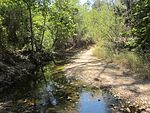Latin American Bible Institute, California
1926 establishments in CaliforniaAssemblies of God seminaries and theological collegesAvocado Heights, CaliforniaBible collegesCalifornia university stubs ... and 3 more
Educational institutions established in 1926La Puente, CaliforniaPentecostalism in California
Latin American Bible Institute, California (LABI) is a private coed Bible college in the Avocado Heights district of La Puente, California. It was founded in 1926. In 1950 the institute moved to its current location in La Puente.The institute was granted an exception to Title IX in 2016 which allows it to legally discriminate against LGBT students for religious reasons. It is ranked among the "Absolute Worst Campuses for LGBTQ Youth" by Campus Pride.
Excerpt from the Wikipedia article Latin American Bible Institute, California (License: CC BY-SA 3.0, Authors).Latin American Bible Institute, California
Avocado Heights trail, El Monte
Geographical coordinates (GPS) Address External links Nearby Places Show on map
Geographical coordinates (GPS)
| Latitude | Longitude |
|---|---|
| N 34.031388888889 ° | E -117.98916666667 ° |
Address
Latin America Bible Institute
Avocado Heights trail
91746 El Monte
California, United States
Open on Google Maps









